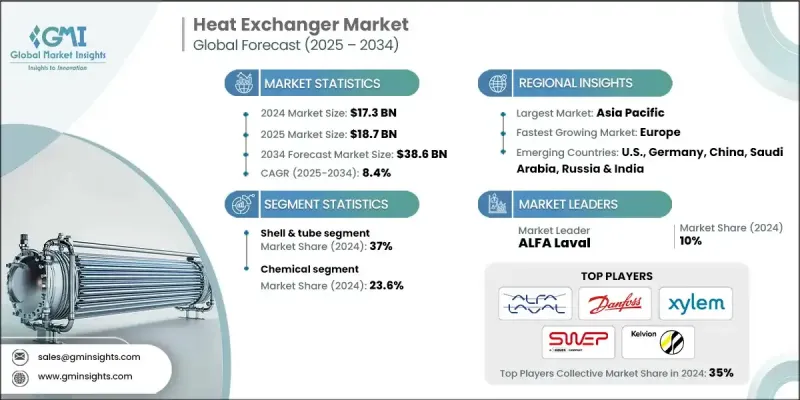
|
市場調査レポート
商品コード
1833660
熱交換器の市場機会、成長促進要因、産業動向分析、2025~2034年予測Heat Exchanger Market Opportunity, Growth Drivers, Industry Trend Analysis, and Forecast 2025 - 2034 |
||||||
カスタマイズ可能
|
|||||||
| 熱交換器の市場機会、成長促進要因、産業動向分析、2025~2034年予測 |
|
出版日: 2025年09月15日
発行: Global Market Insights Inc.
ページ情報: 英文 135 Pages
納期: 2~3営業日
|
概要
熱交換器の世界市場規模は2024年に173億米ドルとなり、CAGR 8.4%で成長し、2034年には386億米ドルに達すると予測されています。

重工業への投資の増加や、建築インフラにおける効率的な冷暖房のニーズの高まりが、市場情勢を形成しています。熱交換器は複数の流体間で熱を伝達するために不可欠であり、エネルギー効率を高め、さまざまな分野でのコスト削減に貢献しています。産業・商業インフラの継続的な開発とともに、エネルギーの最適化が重視されるようになり、より高度な熱交換技術への需要が加速しています。これらの装置は、化学、石油化学、石油・ガス、発電、HVACなど、さまざまな産業で重要な役割を担っています。持続可能性と規制遵守への関心の高まりは、耐久性、性能、多様な環境への適応性を向上させる技術革新をメーカーに促しています。さらに、製品の信頼性を高め、多様な用途に対応することを目的とした研究開発投資の増加が、市場拡大をさらに後押ししています。
| 市場範囲 | |
|---|---|
| 開始年 | 2024 |
| 予測年 | 2025-2034 |
| 市場規模 | 173億米ドル |
| 予測金額 | 386億米ドル |
| CAGR | 8.4% |
シェル&チューブ分野は2024年に37%のシェアを占め、2034年までCAGR 8.3%で成長すると予想されます。この成長の原動力は、化学、石油・ガス、飲食品などの産業における需要の増加と、エネルギー効率重視の高まりです。製造活動や産業プロジェクトの拡大、特殊化学プロセスの重要性の高まりが、引き続き市場力学をポジティブに形成しています。
化学産業セグメントは2024年に23.6%のシェアを占め、2025年から2034年にかけてCAGR 9.2%で成長すると予測されています。化学製品の需要急増と省エネルギーや持続可能性の重視が相まって、この分野での最先端の熱交換器ソリューションの採用が進んでいます。さらに、厳しい安全規制とセンサーやデータ分析などのデジタル技術の統合が、カスタマイズされた化学施設内のリアルタイム監視、予知保全、運転制御を強化しています。
米国の熱交換器市場は83.8%のシェアを占め、2024年には27億米ドルを生み出しました。同国の強力な産業基盤は、野心的なネットゼロ排出目標、厳しい環境規制、インフラの近代化、熱交換器システムの技術進歩に後押しされ、エネルギー効率の高い冷暖房ソリューションを採用しています。これらの要因が総体的に市場を前進させています。
熱交換器市場の主要企業には、Nexson、API Heat Transfer、Accessen Group、HRS Heat Exchangers、SWEP International、Danfoss、Bronswerk、Alfa Laval、Kelvion Holding、Koch Heat Transfer、Euro-Apex、Thermowave、Funke Warmeaustauscher Apparatebau、Thermofin、Wessels Company、Mersen、Hisaka Works、Xylemなどがあります。熱交換器市場の企業は、市場での存在感を確固たるものにするため、イノベーションと持続可能性に重点を置いています。エネルギー効率、製品の耐久性、特定の産業ニーズに合わせたカスタマイズ能力を向上させるため、研究開発に多額の投資を行っています。産業界のパートナーとのコラボレーションにより、進化する規制基準や環境目標を満たす高度なソリューションを生み出しています。企業はまた、戦略的パートナーシップ、買収、地域市場に対応するための現地生産を通じて、グローバルな足跡を拡大することを優先しています。
目次
第1章 調査手法と範囲
第2章 エグゼクティブサマリー
第3章 業界考察
- エコシステム分析
- 原材料の入手可能性と調達分析
- バリューチェーンに影響を与える主な要因
- ディスラプション
- 規制情勢
- 業界への影響要因
- 促進要因
- 業界の潜在的リスク&課題
- 成長可能性分析
- ポーター分析
- PESTEL分析
- 熱交換器のコスト構造の内訳
- 新たな機会と動向
- IoTテクノロジーによるデジタル変革
- 新興市場への浸透
- 投資分析と将来展望
第4章 競合情勢
- イントロダクション
- 企業の市場シェア分析:地域別
- 北米
- 欧州
- アジア太平洋地域
- 中東・アフリカ
- ラテンアメリカ
- 戦略的取り組み
- 主要なパートナーシップとコラボレーション
- 主要なM&A活動
- 製品の革新と発売
- 市場拡大戦略
- 競合ベンチマーキング
- 戦略的ダッシュボード
- イノベーションと持続可能性の情勢
第5章 市場規模・予測:技術別、2021-2034
- 主要動向
- シェル&チューブ
- 皿
- 空冷式
- その他
第6章 市場規模・予測:用途別、2021-2034
- 主要動向
- 石油・ガス
- 化学薬品
- 発電および冶金
- 海洋
- 機械産業
- セントラルヒーティングと冷蔵
- 食品加工
- その他
第7章 市場規模・予測:地域別、2021-2034
- 主要動向
- 北米
- 米国
- カナダ
- メキシコ
- 欧州
- ドイツ
- 英国
- フランス
- ロシア
- イタリア
- スペイン
- ポーランド
- トルコ
- アジア太平洋地域
- 中国
- 日本
- 韓国
- インド
- インドネシア
- マレーシア
- タイ
- ベトナム
- フィリピン
- オーストラリア
- 中東・アフリカ
- サウジアラビア
- アラブ首長国連邦
- エジプト
- 南アフリカ
- ナイジェリア
- ラテンアメリカ
- ブラジル
- アルゼンチン
- コロンビア
- チリ
第8章 企業プロファイル
- Accessen Group
- Alfa Laval
- AMI Exchangers
- API Heat Transfer
- Bronswerk
- Danfoss
- Euro-Apex
- Funke Warmeaustauscher Apparatebau
- Hisaka Works
- HRS Heat Exchangers
- Kelvion Holding
- Koch Heat Transfer
- Mersen
- Nexson
- SPX Flow
- SWEP International
- Thermofin
- Thermowave
- Wessels Company
- Xylem

